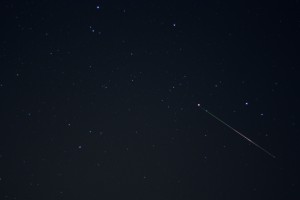August 12, 2013
Perseids Meteor Watch
Report by: Mike Meynell
On setting out on the journey to Cudham to see if we could catch sight of some Perseid meteors, the weather conditions reminded me of last year’s event, where heavy cloud prevented us from seeing many meteors until the very end of our session. Fortunately, the forecast this year was for the cloud to start clearing at around 11pm.
Arriving at Cudham just before 10pm, a few Flamsteed members took the opportunity to have a quick drink in the always friendly Blacksmith’s Arms, before heading out to the recreation ground behind the pub. By the time we got out on the recreation ground, there were quite a few people already standing around looking up at the sky. The Moon set at about 10.20pm, leaving us with almost perfect viewing conditions. The weather forecast, for once, proved to be entirely accurate, as the clouds started to part in the north and we were treated to clear skies overhead, right on cue, at 11pm.
Several deck chairs were set up, as we settled in for a few hours of meteor observing. Cameras were set to take regular images of the night sky, in the hope that we might capture a few photographs of the Perseids. Clive set up his radio receiver, using the SpectrumLab software to detect and log meteors as they burnt up in the Earth’s atmosphere. The receiver was tuned to the GRAVES transmitter in France, so we didn’t expect that meteors seen in the sky overhead would correlate to those detected on the receiver. However, in several cases, particularly for the brighter meteors, there was a definite correlation between the two. Several times, we saw a meteor overhead followed by a loud ‘ping‘ from Clive’s laptop. Very interesting stuff.
During the observing session, we saw several long, bright meteors, with a few that left visible dust trails in the sky. Colours were also evident on some of the brighter meteors. I saw several yellow meteor trails and some people reported seeing green trails in some cases. The meteors seemed to come in groups, with 4 or 5 meteors in a few minutes, followed by a relative lull of 15 minutes or so.
In the end, we started to pack up at around 1am, as activity had died down… and it was getting rather chilly! We’d all seen lots of meteors to sate our appetites in any case.
I’d taken around 200 images of the night sky over the course of the evening… typically, not one contained even a hint of a Perseid! Rather than waste the images, I made them into a ‘star trails’ picture, which you can see below. Clive, however, was luckier. He managed to get a lovely image of a Perseid meteor, which also shows a change in colour from green to yellow to blue, as the different layers of the meteor, containing different elements, burnt up in the atmosphere. Again, you can see this image below.
So, a fun evening was had by all that attended. Many thanks to the 20 or so Flamsteed members who made it along. If you managed to get a picture of a Perseid, let us know and (with your permission) we will post it on to this report.
UPDATE: Flamsteed member John Williams has sent us through 3 pictures of the Perseids which he managed to capture on the evenings of 12/13 August. The images can be seen in the gallery below.
Pictures from the Event:
Posted under: Flamsteed, Meeting Report, Meteor Watch, Perseids, Radio Astronomy







You must be logged in to post a comment.